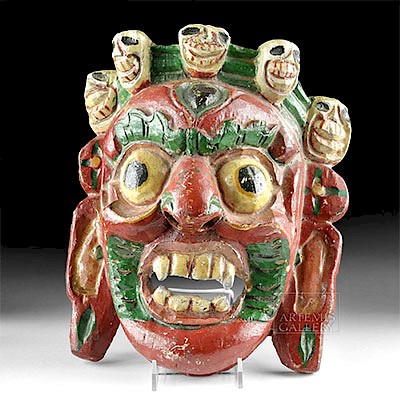Veracruz Stone Palma - Turkey Form
Lot 104h
About Seller
Artemis Fine Arts
686 S Taylor Ave, Ste 106
Louisville, CO 80027
United States
Selling antiquities, ancient and ethnographic art online since 1993, Artemis Gallery specializes in Classical Antiquities (Egyptian, Greek, Roman, Near Eastern), Asian, Pre-Columbian, African / Tribal / Oceanographic art. Our extensive inventory includes pottery, stone, metal, wood, glass and textil...Read more
Estimate:
$2,000 - $3,000
Absentee vs Live bid
Two ways to bid:
- Leave a max absentee bid and the platform will bid on your behalf up to your maximum bid during the live auction.
- Bid live during the auction and your bids will be submitted real-time to the auctioneer.
Bid Increments
| Price | Bid Increment |
|---|---|
| $0 | $25 |
| $300 | $50 |
| $1,000 | $100 |
| $2,000 | $250 |
| $5,000 | $500 |
| $10,000 | $1,000 |
| $20,000 | $2,500 |
| $50,000 | $5,000 |
| $100,000 | $10,000 |
| $200,000 | $20,000 |
About Auction
By Artemis Fine Arts
Apr 25, 2019
Set Reminder
2019-04-25 10:00:00
2019-04-25 10:00:00
America/New_York
Bidsquare
Bidsquare : Pre-Columbian | Tribal | Ethnographic
https://www.bidsquare.com/auctions/artemis-gallery/pre-columbian-tribal-ethnographic-4035
Featuring ancient and ethnographic art from around the world, including Pre-Columbian, Native American, African / Tribal, Ethnographic, Spanish Colonial, Fossils, Fine Art, much more. Artemis Fine Arts info@artemisgallery.com
Featuring ancient and ethnographic art from around the world, including Pre-Columbian, Native American, African / Tribal, Ethnographic, Spanish Colonial, Fossils, Fine Art, much more. Artemis Fine Arts info@artemisgallery.com
- Lot Description
Pre-Columbian, Gulf Coast of Mexico, Veracruz culture, ca. 500 to 700 CE. A volcanic palma stone, carved by hand, in the shape of a dramatic male wild turkey, standing, its massive plumage spread behind it. Its head is bent downward, with large eyes, a segmented, curved beak, and a large crest rising from the top of the head and back of the neck. Strangely, the bird has human-like hands, which grasp something that is also caught between its beak, giving the impression that the bird is in the process of eating prey. Size: 4.5" W x 8" H (11.4 cm x 20.3 cm); 10.55" H (26.8 cm) on included custom stand.
The true palma was a heavy piece of leather worn by athletes during the Mesoamerican ballgame; stones like this one were carved to represent it in sculptural form. Stone palmas may have been given as awards or displayed in temples; the relationship between the ballgame and religion remains unclear, but there certainly seems to be a connection. The turkey theme relates to concepts of sacrifice, death, and rebirth, the struggles of the ballgame.
See a similar example at the Metropolitan Museum of Art: https://www.metmuseum.org/art/collection/search/307649
Provenance: private southern California, USA collection, acquired in the 1970s to mid-1980s
All items legal to buy/sell under U.S. Statute covering cultural patrimony Code 2600, CHAPTER 14, and are guaranteed to be as described or your money back.
A Certificate of Authenticity will accompany all winning bids.
We ship worldwide and handle all shipping in-house for your convenience.
#140796Upper part of wing has a chip from it, as does the lower body. Both appear to be ancient losses and are smooth. The surface is weathered, with light deposits, but much of the detail, especially of the upper body, is well preserved.Condition
- Shipping Info
-
All shipping is handled in-house for your convenience. Your invoice from Artemis Gallery will include shipping calculation instructions. If in doubt, please inquire BEFORE bidding for estimated shipping costs for individual items.
-
- Buyer's Premium



 EUR
EUR CAD
CAD AUD
AUD GBP
GBP MXN
MXN HKD
HKD CNY
CNY MYR
MYR SEK
SEK SGD
SGD CHF
CHF THB
THB














